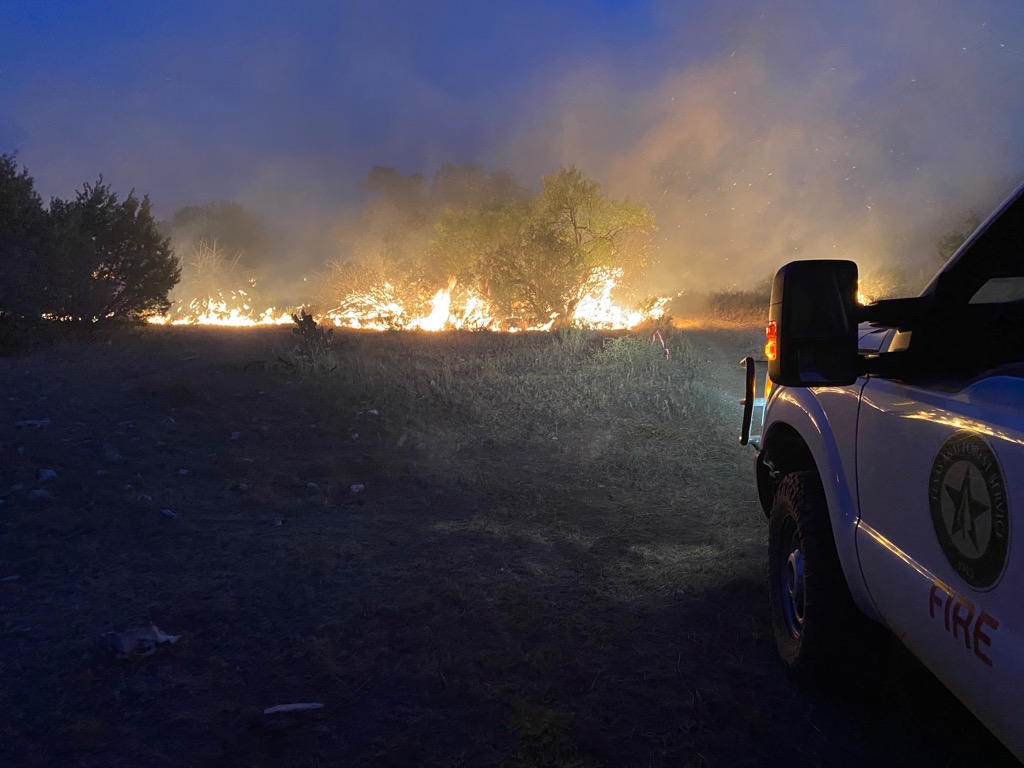Wildfire activity increasing statewide under current weather pattern
Hot, dry pattern expected to continue as Texas enters late summer fire season
The weather pattern for the upcoming week will be hot and dry due to an upper level ridge of high pressure positioned over the state, according to the Texas A&M Forest Service. This pattern is similar to what was observed July 9-17, when wildfire activity increased across much of the state. During this period of time, state and local resources responded to 205 wildfires that burned a total of 45,376 acres.
Fire environment—weather, fuels and current conditions
Forecasted triple digit temperatures will produce a high rate of drying in wildland vegetation, which will increase the risk of wildfire activity. The combination of elevated fire weather — higher wind speed and lower humidity– and dry wildland vegetation may produce wildfires that are hard to control.
“We are entering our late summer fire season when we normally expect an increase in wildfire activity,” said Brad Smith, Texas A&M Forest Service Predictive Services Department head. “The hot and dry conditions forecast for next week, as well as the presence of underlying drought conditions west of Interstate 35, raise concerns for significant wildfire activity. These wildfires will be very resistant to control and require more time and more firefighters to extinguish.”
For current conditions and wildfire outlook, check out the Texas Fire Potential Outlook.
Fire activity
Over the past seven days, state and local resources have responded to 53 wildfires that have burned about 12,090 acres. This includes many large, multi-day fires, including the still-burning Mays Fire in San Saba and McCulloch counties at 9,500 acres that is 75% contained, and the Pocket Complex in Val Verde and Crockett counties at 625 acres that is 70% contained.
Aviation resources have been heavily utilized this wildfire season to assist ground crews in working hotspots and slowing the forward progress of fires. Fire suppression aircraft have logged approximately 160 hours of flight time over the past week. Efforts involved dropping 56,000 gallons of water and 85,000 gallons of retardant on the Pocket Complex, Mays Fire, Beaver Creek Fire in Wilbarger County and Flag Pond Fire in Lee County.
Aviation resources staged in state include two Type 1 helicopters, two Type 3 helicopters, nine single- engine air tankers, one heavy air tanker, one lead plane and two air-attack platforms.
Since Jan. 1, state and local resources have responded to 3,077 fires that have burned a total of 171,204 acres. Aviation resources have flown 1,423 hours, dropping 1,335,172 gallons of water and retardant on Texas wildfires so far this year.
If a wildfire is spotted, immediately contact local authorities. A quick response can help save lives and property.
For frequent wildfire and incident updates, follow the Texas A&M Forest Service incident information Twitter account.
Prevention and Mitigation
Nine out of 10 wildfires in Texas are caused by humans. Exercise extreme caution when working outdoors with heavy equipment.
- Ensure your equipment is regularly maintained. Malfunctioning equipment can spark or overheat and cause a wildfire.
- Remove rocks and metal from the work area.
- Check equipment frequently for trapped debris and check bearings for signs of overheating.
- Avoid parking or idling in dry grass. The catalytic converter underneath your vehicle can get hot enough to ignite any vegetation beneath it.
- Have a spotter nearby with a water source or fire extinguisher on hand in case a spark or hot equipment does cause an ignition.
- If possible, avoid operating heavy equipment until fire danger conditions improve.
“State and local firefighters are extremely busy with current wildfire suppression activities across the state,” said Bruce Woods, Texas A&M Forest Service Mitigation and Prevention Department head. “Citizens can help our first responders work in a safer environment by taking personal responsibility and preparing their property before a fire starts.”
Successfully preparing for a wildfire requires everyone to take personal responsibility for protecting themselves, their families and their properties.
Texas A&M Forest Service encourages Texans to take the following steps around their homes today to reduce the risk of wildfire:
- Create a defensible space around your home to allow for low-intensity, slow-burning conditions in the event of a wildfire.
- A healthy, well-maintained landscape is important to the survival of homes during a wildfire. Within the first 30 feet of your home, use non-flammable landscaping materials. Within the first 5 feet, water plants, trees and mulch regularly, and consider xeriscaping if you are affected by water restrictions.
- Make sure plants are carefully spaced, low-growing and free of resins, oils and waxes that burn easily.
- Remove dead vegetation from under decks and within 10 feet of the house.
- Prune trees 6-10 feet up from the ground.
Taking simple steps to help maintain your property could save it during a wildfire. Learn more about how to create defensible space around your home.
Residents should pay attention to county burn bans and avoid all outdoor burning until conditions improve. Burn ban information can be found by contacting local fire departments or Texas A&M Forest Service.






